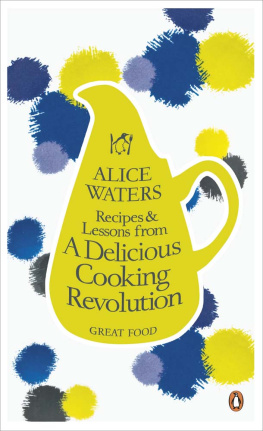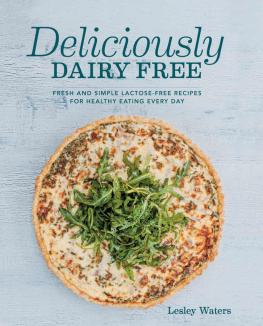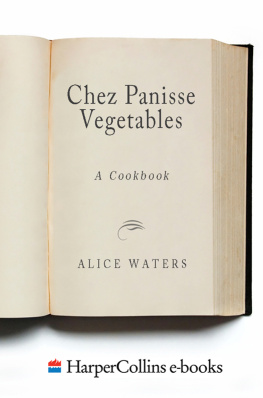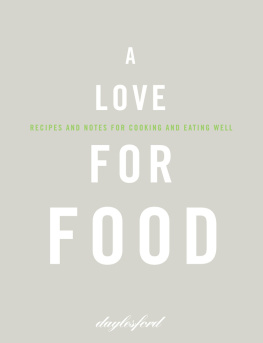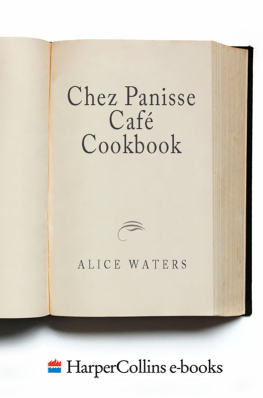Recipes and Lessons from a Delicious Cooking Revolution
ALICE WATERS
PENGUIN BOOKS
PENGUIN BOOKS
Published by the Penguin Group
Penguin Books Ltd, 80 Strand, London WC2R 0RL, England
Penguin Group (USA) Inc., 375 Hudson Street, New York, New York 10014, USA
Penguin Group (Canada), 90 Eglinton Avenue East, Suite 700, Toronto, Ontario, Canada M4P 2Y3 (a division of Pearson Penguin Canada Inc.)
Penguin Ireland, 25 St Stephens Green, Dublin 2, Ireland
(a division of Penguin Books Ltd)
Penguin Group (Australia), 250 Camberwell Road, Camberwell, Victoria 3124, Australia
(a division of Pearson Australia Group Pty Ltd)
Penguin Books India Pvt Ltd, 11 Community Centre, Panchsheel Park, New Delhi 110 017, India
Penguin Group (NZ), 67 Apollo Drive, Rosedale, Auckland 0632, New Zealand
(a division of Pearson New Zealand Ltd)
Penguin Books (South Africa) (Pty) Ltd, 24 Sturdee Avenue, Rosebank, Johannesburg 2196, South Africa
Penguin Books Ltd, Registered Offices: 80 Strand, London WC2R 0RL, England
www.penguin.com
The Art of Simple Food first published 2007
This extract published in Penguin Books 2011
Copyright Alice Waters, 2007
All rights reserved
The moral right of the author has been asserted
Cover design based on Ikat pattern from a dinnerware range designed by Vera Wang for Wedgwood, 2010. Picture research by Samantha Johnson. Lettering by Stephen Raw
Except in the United States of America, this book is sold subject to the condition that it shall not, by way of trade or otherwise, be lent, re-sold, hired out, or otherwise circulated without the publishers prior consent in any form of binding or cover other than that in which it is published and without a similar condition including this condition being imposed on the subsequent purchaser
ISBN: 978-0-14-196606-9
PENGUIN BOOKS GREAT FOOD
Recipes and Lessons from a Delicious Cooking Revolution
ALICE WATERS , chef, author, and the proprietor of Chez Panisse, is an American pioneer of a culinary philosophy that maintains that cooking should be based on the finest and freshest seasonal ingredients that are produced sustainably and locally. She is a passionate advocate for a food economy that is good, clean, and fair. Over the course of nearly forty years, Chez Panisse has helped create a community of scores of local farmers and ranchers whose dedication to sustainable agriculture assures the restaurant a steady supply of fresh and pure ingredients. Waters is Vice President of Slow Food International, and the author of eight books, including The Art of Simple Food: Notes and Recipes from a Delicious Revolution, from which this selection is taken. She is the recipient of many awards, including the French Lgion dHonneur.
EAT LOCALLY AND SUSTAINABLY
Learn where your food comes from and how it is produced. Seek out a diverse variety of vegetables and fruits from small, local producers who take care of the land. Buy eggs, meat and fish from producers whose practices are organic, humane and environmentally sound.
EAT SEASONALLY
Choose food in season. Even where the growing season is short, organic gardening and farming can extend it: greens can be grown in cold frames and greenhouses, and there are always local foods that can be stored, dried and preserved for the winter months. Eating seasonally inspires your menus, gives you a sense of time and place and rewards you with the most flavourful food.
SHOP AT FARMERS MARKETS
Farmers markets create communities that value diversity, honesty, seasonality, locality, sustainability and beauty. Get to know the people who grow your food. Think of yourself as in partnership with the farmers, learning from them and working with them.
PLANT A GARDEN
It is deeply satisfying to eat food you have grown yourself, in your own garden or in an allotment. Even a pot of herbs on your windowsill can transform your cooking and connect you to the changing seasons, as can foraging for wild foods and harvesting fruit from farms that allow you to pick your own. Learn what the edible landscape has to offer.
CONSERVE, COMPOST AND RECYCLE
Take your own basket to the market. Reuse whatever packaging you can. Keep a compost bucket nearby when you cook to recycle kitchen scraps. The more you conserve, the less you waste, the better you feel.
COOK SIMPLY, ENGAGING ALL YOUR SENSES
Plan uncomplicated meals. Let things taste of what they are. Enjoy cooking as a sensory pleasure: touch, listen, watch, smell and, above all, taste. Taste as you go. Keep tasting and keep practising and discovering.
COOK TOGETHER
Include your family and friends, and especially children. When children grow, cook and serve food, they want to eat it. The hands-on experience of gardening and cooking teaches children the value and pleasure of good food almost effortlessly.
EAT TOGETHER
No matter how modest the meal, create a special place to sit down together and set the table with care and respect. Savour the ritual of the table. Mealtime is a time for empathy and generosity, a time to nourish and communicate.
REMEMBER, FOOD IS PRECIOUS
Good food can only come from good ingredients. Its proper price includes the cost of preserving the environment and paying fairly for the labour of the people who produce it. Food should never be taken for granted.
What to Cook?
At some point in every day, the question arises, Whats for dinner? That is when I try to collect my thoughts and decide what to cook. I embark on an internal dialogue thats different every time: What do I feel like having? Who else is eating? Whats the weather like? How much time do I have? How much energy do I want to put into it? Whats in the fridge? Whats at the market? Whats my budget? As you answer these questions, different solutions will suggest themselves and youll go back and forth, weighing the alternatives. The process has a rhythm of its own, whether youre deciding on a menu for a simple family meal at home or for a gathering of friends celebrating a special occasion.
PLANNING MENUS
When planning menus, I try to think fluidly and consider the possibilities for more than one day at a time. When you cook regularly, you fall naturally into a routine of planning ahead a little. I find that the key is to shop well so that I have a good selection of ingredients on hand: some meats and poultry perhaps, a variety of vegetables, salad and fruit. After shopping, I come home and make a few preparations: season the chicken, marinate pork chops with herbs and seasoning, soak some beans. Having these things in the refrigerator, ready to cook, is a comforting start: I dont have to worry at the last minute, or at the end of a tiring day, about what I can possibly make for dinner. Instead I can consider which of those things I want to cook and what to combine with them. Usually I will begin with a primary ingredient such as a chicken. I may decide to roast it, and then I choose a vegetable or a combination of vegetables, or rice or salad and so on, mentally reviewing the contents of the refrigerator and the pantry. In the process, the ingredients I dont choose become the basis of the next nights dinner.
This process is typical for me because I like to shop without a detailed plan, feeling open to whatever looks best at the market and is particularly fresh and seasonal. I then make menus around what I find. Another approach is to plan some menu ideas and a shopping list before going to the market, and that can be a stimulating way to think through ideas and be organized and efficient. However, it is good to be able to alter the plan and the list on the spot to accommodate the discoveries at the market. If you have really good ingredients you can always make something delicious with them.

